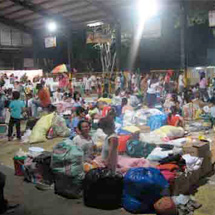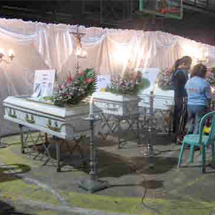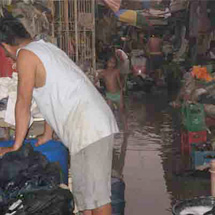On 26 September 2009, Typhoon Ketsana made landfall in the Luzon area of the Philippines, killing more than 300 people and destroying over 10,000 homes.
While the Philippines regularly copes with flooding, Ketsana struck with an unusual force that surprised even this typhoon-hardened country.
In a matter of hours, widespread flooding devastated metropolitan Manila and the nearby provinces of Bulacan, Rizal, Laguna and the island of Southern Luzon. Metro Manila and at least 23 provinces were placed under a "state of calamity."
“A month’s worth of rain fell in just a few hours,” said Rodolfo Gaspar Jr., a Filipino national whose family home in Manila was damaged in the flooding. “Filipinos are very used to coping with flooding, but many were caught off guard by the severity of the storm.”

As is often the case in disasters, urban poor communities were especially hard-hit. Between one third and one half of the urban population in the Philippines lives in informal, illegal settlements without access to toilets, clean water and electricity. These settlements are particularly vulnerable to disaster because they are generally located in high risk areas, with makeshift structures and a high population density.
One organisation that has been actively responding to the needs of the urban poor in the aftermath of Ketsana is the Homeless People’s Federation Philippines Inc (HPFPI, or the Federation), which is affiliated with Shack/Slum Dwellers International (SDI).
In a report titled “The Impact of Typhoon Ketsana” posted on SDI’s website, the Federation outlined its initial response to the typhoon, which was locally known as “Ondoy.”
With so many people affected, a major response was required. As of 8 October, 337 people had been killed, 308 injured and 37 still missing, according to a government report.

The total number of people affected by the typhoon stood at 4,119,658—some 838,103 families. More than 10,000 homes were partially or totally damaged.
Initial nationwide and international responses to the typhoon focused on immediate relief efforts, including rescue operations and the provision of food and clothing for victims. International private donations were also expected to be channeled to relief efforts.
The Federation in particular centered its efforts on helping affected urban poor communities in its priority areas in Quezon City, Bulacan and Montalban, Rizal.
The Federation would now like to focus on medium and long-term rehabilitation for those affected by the typhoon.
Expressed needs of communities in priority areas that are currently not being met include:
-- Provision for transitory shelter to families whose homes were completely destroyed.
-- Fund for house repair/reinforcement for families whose homes were damaged but are unfit for habitation.
-- Operational fund to mobilise the immediate response to the victims.

Because flooding due to typhoons is a regular occurrence in the Philippines, the Federation is seeking funding to establish a Disaster Fund.
Such a fund would allow it to provide both immediate crisis intervention as well as long-term crisis response, including loans for businesses and land purchase as well as data collection about settlements in danger zones.
While organisations such as the Federation can play a major role in helping the urban poor cope with climatic disasters, the active involvement of local and national governments is crucial.
“The leadership within the Federation has actively engaged their city mayors in a joint dialogue to find solutions that work for the city and the urban poor settlements,” said Celine d’Cruz, a global coordinator for SDI.
“But there is only so much they can do on their own as a social movement and need the support of their city and other stakeholders to help them realise their dream for a secure home,” she added. “Many of the city mayors now see the federation as an asset and call them to advise the city in many related issues.”
For More Information
Download “The Impact of Typhoon Ketsana”
For more information about the Federation, please visit its website.
For more about how the Federation is helping the urban poor cope with climatic disasters in the Philippines, please see the article by Celine d’Cruz titled “Leadership in Urban Areas” in the July 2009 issue of Tiempo.




